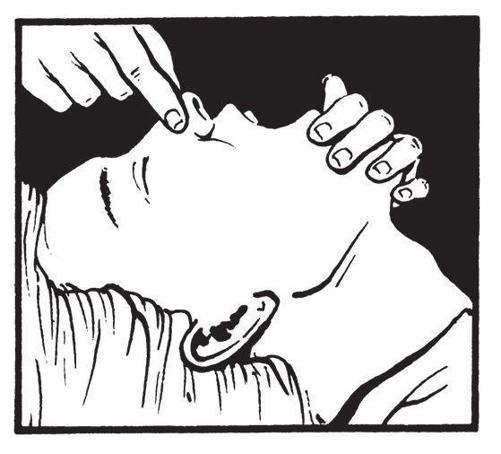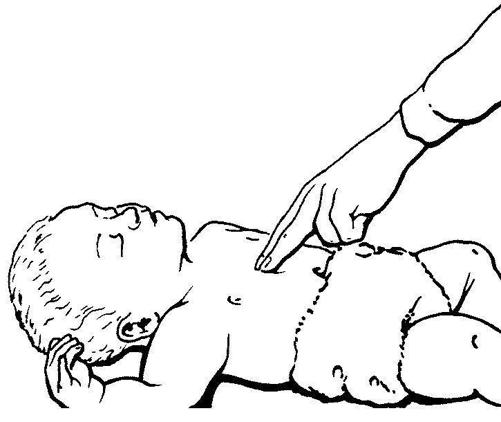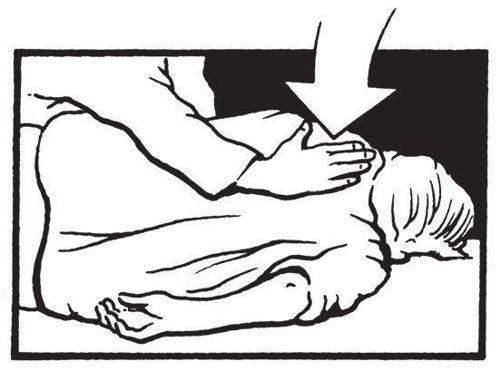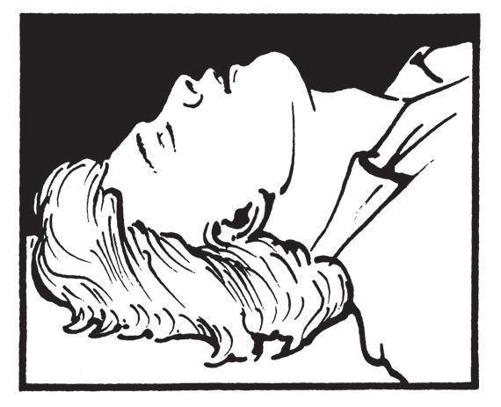SAS Urban Survival Handbook (131 page)
Read SAS Urban Survival Handbook Online
Authors: John Wiseman
Tags: #Health & Fitness, #Reference, #Survival, #Fiction, #Safety, #Self-Help, #Personal & Practical Guides, #General, #Survival Skills

If a check tells you that a vital body function is impaired, act IMMEDIATELY. If you are alone, stabilize the casualty before leaving to find a telephone. If you have help, send someone to phone for an ambulance while you attend to the casualty.
BREATHING
If a casualty has stopped breathing, oxygen cannot enter the body and they will die in minutes—irreversible brain damage can occur after four minutes. If the airway is clear, but there is no breathing, begin artificial respiration. The best method is mouth-to-mouth, although mouth-to-nose and mouth-to-mouth-and-nose are also used.
Mouth-to-mouth
Also known as the kiss of life, the aim is to get air into the lungs. Position the head to ☜ OPEN AIRWAY. Check for blockages in the mouth/throat. Remove loose dentures (leave fixed ones). Loosen restrictive clothing around casualty’s throat and chest.

Make sure the head and chin are tilted well back. Hold the nostrils closed with a finger and thumb.

Seal your mouth over casualty’s mouth and blow two quick breaths (inflations), watching the chest. It should rise. Remove your mouth and chest will fall. If chest does NOT rise, the airway may still be blocked. Check airway is open. You may need to treat casualty for CHOKING ☛
Check ☜ PULSE. If there is no pulse, use CARDIAC COMPRESSION ☞ Continue mouth-to-mouth at a rate of 12-16 inflations a minute until breathing is restored. DON’T GIVE UP. You may need to assist the casualty’s breathing with further inflations. When the casualty is breathing independently, place in RECOVERY POSITION ☞
REMEMBER
If it is not possible to use casualty’s mouth for artificial respiration, use nostrils instead. Seal casualty’s mouth with thumb and put your mouth over nostrils. Proceed with artificial respiration. This method is useful if the mouth is injured or in cases of suspected poisoning, where you may be at risk of contamination.
BABY/CHILD
Infants need special techniques for artificial respiration:
- ■
Seal your mouth round baby’s/child’s mouth AND nostrils. Don’t tilt a baby’s head back too far. - ■
Breathe gently into lungs at a rate of 20 inflations a minute. - ■
Check pulse after two inflations—see
☚
PULSE.
CIRCULATION
Your ☜ PULSE check will tell you if the casualty’s heart is beating. If it has stopped, there is no point in continuing with only artificial respiration because blood circulation is necessary to take oxygen to the brain. The heart must be squeezed between breastbone and spine, effectively operating it like a hand pump. Cardiac compression must be applied
in conjunction with
mouth-to-mouth.

WARNING
Compression should ONLY be carried out by someone who is trained in first aid, who has had practice in the technique and who can establish conclusively whether or not the casualty’s heart has stopped. NEVER give compression if the heart IS beating—even if only a very faint pulse can be felt. You could stop the heart.
Cardiac compression
Lay the casualty on their back on a firm surface and kneel at their side. Place heel of one hand on lower half of casualty’s breastbone (sternum)—the central chest bone between the ribs. Make sure your hand is about an inch above where the ribs meet, NOT on the end of the breastbone or below it. Place the heel of the other hand on top. Keep fingers off casualty’s chest.

With arms straight, rock forward and press down about 4 cm (11/2 in) 15 times. The rate should be at about 80 times per minute—that’s more than once per second. Press smoothly and firmly. Erratic or rough pressure could cause injury.
Give two lung inflations, mouth-to-mouth, and continue the sequence—15 compressions, two inflations. Make the first check for victim’s pulse after one minute, thereafter at threeminute intervals. DON’T GIVE UP.
If two first aiders are present,
give five compressions followed by one deep inflation on the upstroke of the fifth compression. Repeat. First aider giving mouth-to-mouth should also check pulse. DON’T GIVE UP.
As soon as a pulse is detected, STOP compressions, but continue mouth-to-mouth until casualty is breathing unaided. Place victim in RECOVERY POSITION ☞
BABY/CHILD
Use less pressure and more compression. For a baby/toddler, light pressure with two fingers is enough, at a rate of 100 compressions per minute. Only depress the chest a out 2.5 cm (1in). For older children up to ten years, use the heel of one hand only and pushlightly 90-100 times per minute to a depth of about 3.5 cm (13/8 in). Give five compressions to one lung inflation.

CHOKING: UNCONSCIOUS
Breathing has stopped, but artificial respiration fails to raise casualty’s chest. The airway is blocked. You MUST remove the obstruction. First clear casualty’s mouth by turning head to one side and sweeping the inside of the mouth with two fingers. DON’T push any object further down the throat! Take particular care when doing this to a baby. If this fails, use:

Back slaps
Roll UNCONSCIOUS casualty onto side and support chest with your thigh. Position casualty’s head well back to open airway. Slap casualty smartly between shoulder blades with heel of your hand. Repeat up to four times if necessary. Check the mouth to see if the blockage has been dislodged.
Abdominal thrust
If back slaps fail, try abdominal thrusts. The aim is to use the air in the casualty’s lungs to dislodge a blockage by a series of thrusts to the upper abdomen. Such action could damage internal organs. Use the abdominal thrust ONLY as a last resort.

Place UNCONSCIOUS casualty on back with head in ☚ OPEN AIRWAY position. Kneel astride casualty’s thighs—if this is not possible, kneel alongside.
